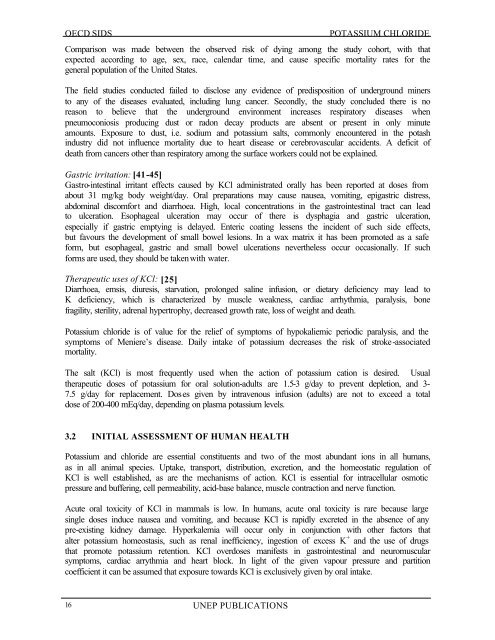POTASSIUM CHLORIDE CAS N°: 7447-40-7
POTASSIUM CHLORIDE CAS N°: 7447-40-7
POTASSIUM CHLORIDE CAS N°: 7447-40-7
You also want an ePaper? Increase the reach of your titles
YUMPU automatically turns print PDFs into web optimized ePapers that Google loves.
OECD SIDS <strong>POTASSIUM</strong> <strong>CHLORIDE</strong><br />
Comparison was made between the observed risk of dying among the study cohort, with that<br />
expected according to age, sex, race, calendar time, and cause specific mortality rates for the<br />
general population of the United States.<br />
The field studies conducted failed to disclose any evidence of predisposition of underground miners<br />
to any of the diseases evaluated, including lung cancer. Secondly, the study concluded there is no<br />
reason to believe that the underground environment increases respiratory diseases when<br />
pneumoconiosis producing dust or radon decay products are absent or present in only minute<br />
amounts. Exposure to dust, i.e. sodium and potassium salts, commonly encountered in the potash<br />
industry did not influence mortality due to heart disease or cerebrovascular accidents. A deficit of<br />
death from cancers other than respiratory among the surface workers could not be explained.<br />
Gastric irritation: [41-45]<br />
Gastro-intestinal irritant effects caused by KCl administrated orally has been reported at doses from<br />
about 31 mg/kg body weight/day. Oral preparations may cause nausea, vomiting, epigastric distress,<br />
abdominal discomfort and diarrhoea. High, local concentrations in the gastrointestinal tract can lead<br />
to ulceration. Esophageal ulceration may occur of there is dysphagia and gastric ulceration,<br />
especially if gastric emptying is delayed. Enteric coating lessens the incident of such side effects,<br />
but favours the development of small bowel lesions. In a wax matrix it has been promoted as a safe<br />
form, but esophageal, gastric and small bowel ulcerations nevertheless occur occasionally. If such<br />
forms are used, they should be taken with water.<br />
Therapeutic uses of KCl: [25]<br />
Diarrhoea, emsis, diuresis, starvation, prolonged saline infusion, or dietary deficiency may lead to<br />
K deficiency, which is characterized by muscle weakness, cardiac arrhythmia, paralysis, bone<br />
fragility, sterility, adrenal hypertrophy, decreased growth rate, loss of weight and death.<br />
Potassium chloride is of value for the relief of symptoms of hypokaliemic periodic paralysis, and the<br />
symptoms of Meniere’s disease. Daily intake of potassium decreases the risk of stroke-associated<br />
mortality.<br />
The salt (KCl) is most frequently used when the action of potassium cation is desired. Usual<br />
therapeutic doses of potassium for oral solution-adults are 1.5-3 g/day to prevent depletion, and 3-<br />
7.5 g/day for replacement. Doses given by intravenous infusion (adults) are not to exceed a total<br />
dose of 200-<strong>40</strong>0 mEq/day, depending on plasma potassium levels.<br />
3.2 INITIAL ASSESSMENT OF HUMAN HEALTH<br />
Potassium and chloride are essential constituents and two of the most abundant ions in all humans,<br />
as in all animal species. Uptake, transport, distribution, excretion, and the homeostatic regulation of<br />
KCl is well established, as are the mechanisms of action. KCl is essential for intracellular osmotic<br />
pressure and buffering, cell permeability, acid-base balance, muscle contraction and nerve function.<br />
Acute oral toxicity of KCl in mammals is low. In humans, acute oral toxicity is rare because large<br />
single doses induce nausea and vomiting, and because KCl is rapidly excreted in the absence of any<br />
pre-existing kidney damage. Hyperkalemia will occur only in conjunction with other factors that<br />
alter potassium homeostasis, such as renal inefficiency, ingestion of excess K + and the use of drugs<br />
that promote potassium retention. KCl overdoses manifests in gastrointestinal and neuromuscular<br />
symptoms, cardiac arrythmia and heart block. In light of the given vapour pressure and partition<br />
coefficient it can be assumed that exposure towards KCl is exclusively given by oral intake.<br />
16<br />
UNEP PUBLICATIONS
















